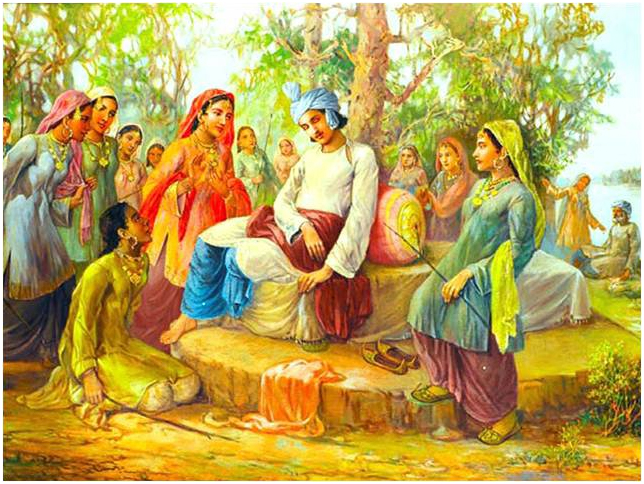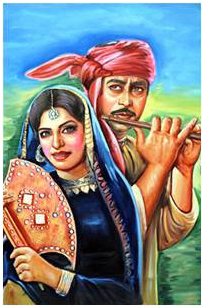|
For the love of God and man

Narrating the tale
Waris Shah is a name to be reckoned with in the tradition of Punjabi Qissa poetry, best known for his seminal work Heer, now considered one of the quintessential works of classical Punjabi literature.
But less known is that Waris Shah borrowed the story and plot of the legend of Heer-Raniha and restructured it. The earlier versions of Heer were written by Damodar (around the time of Mughal Emperor Akbar's reign) and by Ahmad Gujjar.
Punjab was an area which on account of its natural and human resources, as well as its strategic location, played a crucial role in the political fortune of the sub-continent. Economically, trade and manufacture had developed in this area. Traders and administrators played an important role here because Punjab was placed at the juncture of important trade routes to Central Asia. As a result, the history of Punjab had been (and continues to be) witness to many storms interspersed with prosperous, peaceful interludes.
Waris Shah borrowed the story and plot of Heer-Raniha
In the 18th century, Punjab lay exposed to fresh invasions from the northwest. (The Mughal empire was disintegrating and much of India was in turmoil.) Punjab faced the brunt of Persian marauder Nadir Shah and Afghan invader Ahmad Shah Abdali. It was a generally pessimistic time in Punjab, and this is reflected in several maxims and rhyming wisdoms from the time.
The tragic ending of Waris Shah's Heer, when viewed in this social context, seems to tally with the air of pessimism in 18th century Punjab. It is also true that by the time Waris Shah was writing, European literature had become known in South Asia. The tragic trope, so well developed in European literature, may have influenced Waris Shah's writing.
|
A spiritual reading of Heer sees in the story both Allah's might and majesty (jalal) and His gentle grace (jamal)
|
Waris Shah was well grounded in Muslim as well as Hindu tradition. His knowledge was wide ranging, from astronomy, medicine and social rites to the different breeds of horse and cattle in Punjab. Moreover, Waris Shah's Heer reflects a distinct flavour of Punjabiat. The use of folk idioms from rural Punjab, the stark realism of the narrative, set apart the Heer of Waris Shah from its earlier versions.
The Heer of Waris Shah has attracted a variety of interpretations and critical approaches. Interestingly, there is even a Marxist interpretation to the Heer-Ranjha story. And it is true that material concerns seem to be of paramount importance to the author, who weaves in a caustic social commentary and exposes the fabric of the contemporary social network. It is not far-fetched to read the tragedy in Waris Shah's Heer as one in which human values are subverted in the cause of material interests.

Heer and Ranjha in a 1970s film poster
It is said that Waris Shah had an unrequited love for a woman called Bhagbhari. This endowed him with the feelings and insights to express the Heer-Ranjha legend as an unrealized love story, with its many bittersweet emotions.
According to some scholars, the broad categorization of the work as belonging to the "Sufi" genre, quite like the works of other Punjabi poets, robs Punjabi literature of its natural ontological diversity. Nevertheless, there is an undeniable fragrance of Tasawwuf in the the Heer-Ranjha story.
The elusive Heer, like the formless absolute, awakens in Ranjha a a desire that overpowers his mind and heart and does not allow him any peace. The impulse towards union or "wisal" is avoided through a series of narrative incidents that delay the satisfaction love until the seeker is purified. This can be likened to several stations or maqamat that a mureed has to pass through before he attains the final union with the Divine. To achieve this goal, he has to seek the assistance of a spiritual master, the pir who in the Heer-Ranjha story is the yogi of Tila Balnath in Jhelum.
|
There is even a Marxist interpretation to the Heer-Ranjha story
|
The Heer-Ranjha union is entwined with the widespread Sufi notion of annihilation or fana, which is a cause of celebration for the Sufi. The death of a Sufi heralds the ultimate union with the beloved God and is celebrated in the form of his urs. In fact, this is the true birth of the Sufi. A spiritual reading of Heer sees in the story both Allah's might and majesty (jalal) and His gentle grace (jamal).
Waris Shah's knowledge was wide ranging, from astronomy, medicine and social rites to the different breeds of horse and cattle in Punjab
Earning love can be a protracted and painful process for which everything wordly has to be sacrificed, a process which involves much self-mortification. This is the path of truth (haqiqat) and it has to be followed by the Sufi, who reposes an unending trust in God (tawakkul). Waris Shah describes this process in the vivid hues of 18th century Punjab. The vocabulary and similies deployed by him convey devotional emotions with skillfull restraint: though the formulaic plot of Sufi romance contains a set of easily predictable conventions and motifs, Waris Shah's Heer shows a great deal of inventiveness in its depiction of human experience without fundamentally altering the philosophical structure of the tale.
In characteristic Sufi style, Waris Shah exposes the hypocrisy of the priests (ulema) and is obliquely critical of the divisions between people in Punjabi society, the dichotomy between prececpt and practice in Islam, etc. He gives a strong pedagogic message of accommodation in his Heer.
Dr. Fatima Hussain is Associate Professor of History at Delhi University, India.
Curtsey:The Friday Times:
|